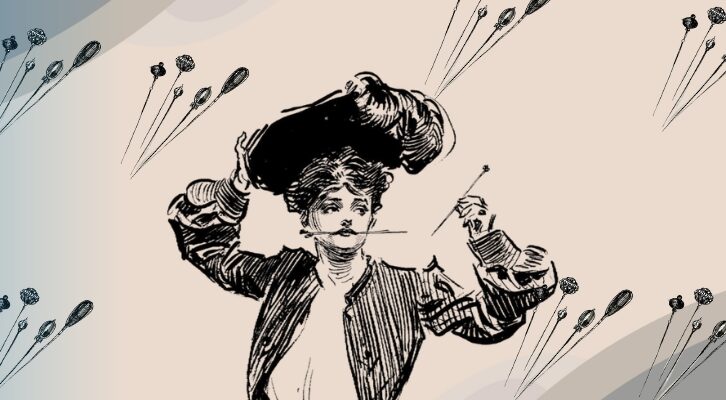
How the Word 'Ghetto' Traveled from Europe to America
Daniel B. Schwartz Explores the Westward Exodus of European Jews
One day in the 1880s, an aspiring author and recent Russian Jewish immigrant set out for the office of the New York Sun with an article he had written in his pocket. His name was Abraham Cahan, and the article he was carrying was “a set of vignettes of life in the Jewish quarter” of New York. Summoning the courage to submit the article for consideration in person, he walked into the Lower Manhattan office of the Sun, a newspaper “then at the peak of its reputation and influence,” and was directed to the chief manuscript reader for the Sunday edition. “We’ll print this next Sunday,” he told a delighted Cahan, encouraging him to “bring him more such copy.” But when Cahan was about to leave, the editor called him back. “Pardon me,” he said. “You use a word about which I must ask. What is a ghetto?”
Recalling this episode in his memoirs some forty years later, when he had become a giant of Yiddish journalism as editor of the Forward and a renowned author of immigrant fiction, Cahan remembered thinking, “Was it possible for an educated man not to know the meaning of that word?” A more charitable interpretation would be that the term ghetto was not yet part of the American lexicon. By the 1920s, however, this unfamiliarity was a distant memory. “Today,” Cahan asserted confidently, “every major American city has a Jewish quarter, some of them as large as a city. And every American understands the meaning of the word ghetto. He knows that it is not the part of the city in which Jews are compelled to live; that kind of ghetto does not exist. It is merely the neighborhood in which large numbers of Jews have settled.”
Of all the turns in the conceptual history of the ghetto, one of the most significant, in terms of both the physical and mental distance traveled, was its migration from Europe to America in the late 19th and 20th centuries. Yet it is fair to ask whether the ghetto was ever “merely the neighborhood in which large numbers of Jews have settled.” At most, it can be said that if it had become possible by the late 1920s to define “ghetto” as “the neighborhood in which large numbers of Jews have settled”—in other words, as a voluntary Jewish quarter—it was only after an extended process of redefinition in which multiple individuals, Cahan prominently among them, had played a part.
As the old mandatory ghettos and Judengassen in Western and Central Europe were dismantled—culminating in the liberation of the last surviving ghetto in the West, in Rome, in 1870—the focus of the struggle for Jewish emancipation was directed to holdouts like Romania and the Russian Empire. With respect to legally imposed segregation, it appeared to many—including to the American Reform rabbi David Philipson, author of the 1894 Old European Jewries—that the only remaining “ghetto” in the world was the largest in the history of the idea, the Pale of Settlement in Tsarist Russia.
To the degree that “ghetto” had also become synonymous with traditional Jewish society—a society depicted as at once isolated and backward, yet also as a vanishing world of authentic Jewishness, in the new genre of ghetto literature—the perception of an eastward migration of the ghetto to Bohemia and Moravia, or to Galicia and Bukovina, received further confirmation. The “ghetto Jew” in the 19th-century Jewish mind became a bearded, Yiddish-speaking, caftan-wearing Eastern European Jew.
Of all the turns in the conceptual history of the ghetto, one of the most significant, in both physical and mental distance traveled, was its migration from Europe to America in the late 19th and 20th centuries.
The return westward of the “ghetto” in the late 19th and early 20th centuries was principally a result of the mass emigration of Jews out of Eastern Europe. Much of the old conventional wisdom about this exodus—most notably, that it began promptly in the wake of the 1881 pogroms in the southern Pale and that it was motivated above all by a desire to escape political violence or conscription in the tsar’s army—has been demonstrated to be false. Though the magnitude of the wave certainly grew substantially in the 1880s, the migration of Russian and Polish Jews had begun earlier in the 19th century and was in fact consistent with a westward shift starting in the 17th and 18th centuries.
And the chief motivation for this outflow, as in most cases of mass immigration, was economic, not political. Over the course of the 19th century, the size of the Jewish community in Eastern Europe (including not only the Russian Pale but also Austrian Galicia and Romania) more than quintupled, yet the Jewish economy—hemmed in by residential restrictions that grew ever stricter, confronted by the competition of surrounding nationalities that were developing their own nascent commercial and professional classes, and limited mostly to light industry and an itinerant peddling that was increasingly outmoded—was unable to keep pace.
As a result, by 1914 more than three million Eastern European Jews had left their country of origin and created new immigrant colonies in cities in the West. Typically, the newcomers settled initially in districts that had long been the site of Jewish neighborhoods and in some cases, at an earlier point, even compulsory ghettos. Vienna’s Jewish population was mainly concentrated in Leopoldstadt, the Habsburg capital’s second district. The site of a mandatory Jewish enclosure in the 17th century, before most Jews were expelled from Vienna for the second time in their history in 1670, Leopoldstadt reemerged as a voluntary Jewish neighborhood in the decades after 1848, with the lifting of the remaining curbs on Jewish residence. In 1880, nearly half (48.3 percent) of Vienna’s Jews lived in Leopoldstadt, accounting for just shy of one-third (29.6 percent) of the district’s total population; by 1910, Leopoldstadt’s total share of Viennese Jews (whose number had climbed from roughly 73,000 to 175,000 in that 30-year span) had fallen to one-third (32.4 percent), though they accounted for a slightly larger percentage of the second district (33.9 percent).
By the end of the 19th century, the poorer sections of Leopoldstadt (including the section to the north known as Brigittenau) were largely occupied by immigrant Jews from the provinces (especially from Habsburg Galicia), and the district “became a ‘Jewish ghetto’ once again in the popular imagination.” This reputation remained intact through the 1930s, especially because the area was further inundated by an influx of Jewish refugees from Eastern Europe in the 1910s and 1920s uprooted by World War I and the numerous wars and pogroms in Poland, Ukraine, and Russia that followed in its wake.
If Vienna had its Leopoldstadt, Paris had its Pletzl (Yiddish for “little square”), located in the fourth arrondissement on the right bank and centered around the Rue des Rosiers. The site of one of the oldest juiveries established in Paris before the expulsion of Jews from France in the 14th century, the area became a Jewish quarter once again in the early 19th century, when it attracted immigrant Jews from Alsace-Lorraine. A century later, its Jewish character remained intact, but the residents were then largely Yiddish-speaking Russian and Romanian Jews. “Its narrow streets,” Paula Hyman writes, “displayed signs in Yiddish, harbored kosher butcher shops and Jewish restaurants, and gave shelter to the petty commerce of immigrant peddlers.”
Paris attracted some 30,000 Eastern European Jewish immigrants between 1881 and 1914. That number climbed to 150,000 in the interwar years, after the United States and Great Britain had essentially closed their doors. While East European Jewish immigrants also settled in Montmartre and between the wars in an area known as Belleville, the Pletzl remained the area of densest concentration and the most slum-like conditions. “The alleys are frightfully dirty,” A. Frumkin wrote in the Jewish Daily Forward of New York in 1912, and “the houses mostly old ruins,” with “12 to 15 persons” often “living in two small rooms.”
The number of Jewish immigrants in Paris climbed to 150,000 in the interwar years, after the United States and Great Britain had essentially closed their doors.
As earlier immigrants moved out of the Pletzl in the 1920s and 1930s, new immigrants moved in, and the representation of the Pletzl as a “ghetto” spread beyond the borders of France. In an article titled “An Evening in the Parisian Ghetto,” written for the Prague Daily Paper in 1925, the author noted, “Like all great cities, Paris, in one of its oldest and filthiest corners behind the Hotel-de-Ville, has its singular ghetto. It is not large, one can traverse it in a quarter of an hour; but the Rue des Rosiers has nonetheless its own, self-contained imprint and from the first house smells completely different from the rest of Paris.”
Berlin’s Jewish quarter could not compare to Leopoldstadt and the Pletzl (not to mention London’s East End or New York’s Lower East Side) in size, in part because East European immigrants to Imperial Germany faced more acute and sustained pressure from both non-Jews and native German Jews to disperse and integrate into German life—or leave the country. Yet there too a miniature immigrant “ghetto” took root before World War I in the streets of the Scheunenviertel (“Barn Quarter”). In 1904, Jacob Thon, a Galician rabbinical student in Berlin, portrayed a stark contrast between the “broad, airy, clean streets” of Berlin where one could “breathe freely“ and the “small, filthy alleys” of the “former Jewish ghetto,” where the “characteristic Judengassen” remain in place and “all the foreign Jewish immigrants concentrate.” Most of these immigrants in pre-World War I Berlin moved out of the Scheunenviertel as soon as they had the chance; in 1910, only 25 percent of Eastern European Jews in Berlin proper lived in the quarter. Still, the “Jewish” reputation of Scheunenviertel endured and was enhanced by the migration of tens of thousands of East European Jews both during World War I (as refugees or forced laborers) and in the Weimar period.
“Wherever Eastern European Jews migrate and settle,” one contemporary observer wrote in 1920, “there is formed without any external compulsion, with more or less sharp contours, a ghetto, the tightest clustering in a territorial sense. Berlin has in the Hiertenviertel, the earlier Scheunenviertel, its typical ghetto.” The author noted that the area was known in the local jargon as the “Jewish Switzerland” and that one of its main streets, Grenadier-straße, was 95 percent Eastern European (and mostly Galician) Jewish and in its language, mores, and customs was cut off from the rest of “great, booming Berlin.” Yet, the Jewish quarter of Berlin was nothing like the great immigrant ghettos of London and New York, in part because the absence of a common “Jewish” industry like the garment trade made it difficult to keep the immigrants clustered together.
“The Eastern European Jews,” she conceded, “are distributed across the center [of the city] to the outermost periphery, and over the years the dispersion within the city divisions has grown stronger.” Despite including Berlin in his overview of “Ghettoes in the West” Joseph Roth also downplayed the degree to which it truly contained a vibrant Jewish neighborhood. Because Berlin was a “point of transit” from which immigrants generally wanted to move on to America, and because the city made more concerted efforts to assimilate newcomers, Berlin’s “ghetto” was hardly a ghetto at all, but “just a couple of small Jewish streets around the Warschauer Brücke and in the Scheunenviertel.”
__________________________________

Excerpted from Ghetto: The History of a Word by Daniel B. Schwartz. Copyright © Daniel B. Schwartz 2019. Reprinted with permission from Harvard University Press.
Daniel B. Schwartz
Daniel B. Schwartz is author of Ghetto and The First Modern Jew: Spinoza and the History of an Image, which was cowinner of the Salo Wittmayer Baron Book Prize for the best first book in Jewish Studies and was a finalist for the National Jewish Book Award in History. He is Associate Professor of History and Judaic Studies at George Washington University and worked on Ghetto as a Kluge Fellow at the Library of Congress and as the Sosland Fellow at the United States Holocaust Memorial Museum.



















